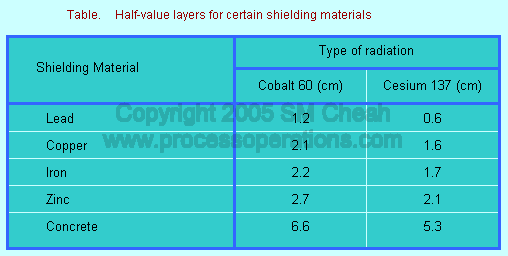Radioactivity Hazards - cont'd
Protection from Ionizing Radiation
The National Council on Radiation Protection published the maximum permissible occupational radiation exposure limits, as shown in the Table.
There is a latent period between initial radiation exposure and observed adverse body effect. The latent period may be long or short, depending on the size of the dose. The response of the various body tissues and organs to identical irradiation may vary considerably.
Ionizing radiation can be detected and monitored with film badges, dosimeters, thermo-luminescence detectors, ionization chambers, and Geiger-Muller counters.
The establishment of a controlled area is basic in radiation protection. Any work area where radiation dose rates are excessive should be guarded by barriers and warning signs, have security guards to restrict entry, or otherwise be isolated from the rest of the workplace.
In protecting humans from ionizing radiation, there are 3
main considerations: time, distance and shielding. These 3 variables are inter-related.
Radiation exposure time and intensity
determine the probability of tissue injury from electromagnetic radiation. Radiation
intensity is dependent upon the energy of the source, the distance from the
source, and the type of protective shielding present, if any. The longer the
time of exposure, the higher the probability of tissue and organ damage.
Shielding can reduce the radiation penetration. Many forms of shielding can be used for radiation protection: cladding on radioactive material, heavy-walled containers, concrete cells, and deep layers of water. Shielding is often expressed in terms of half-value layers, which is the material thickness to reduce the incident radiation by 50%. Selected shielding materials for x-rays are shown in the Table.
